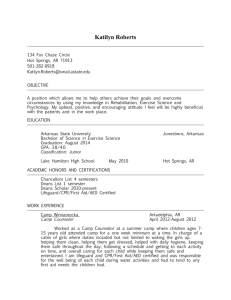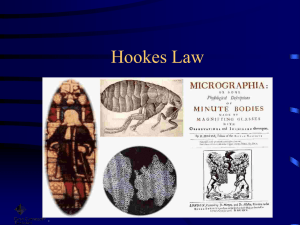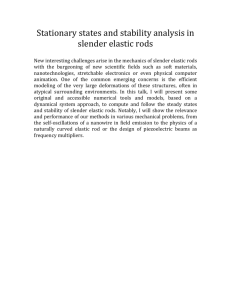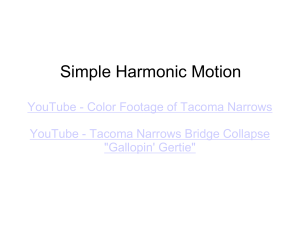Forces and springs topic
advertisement
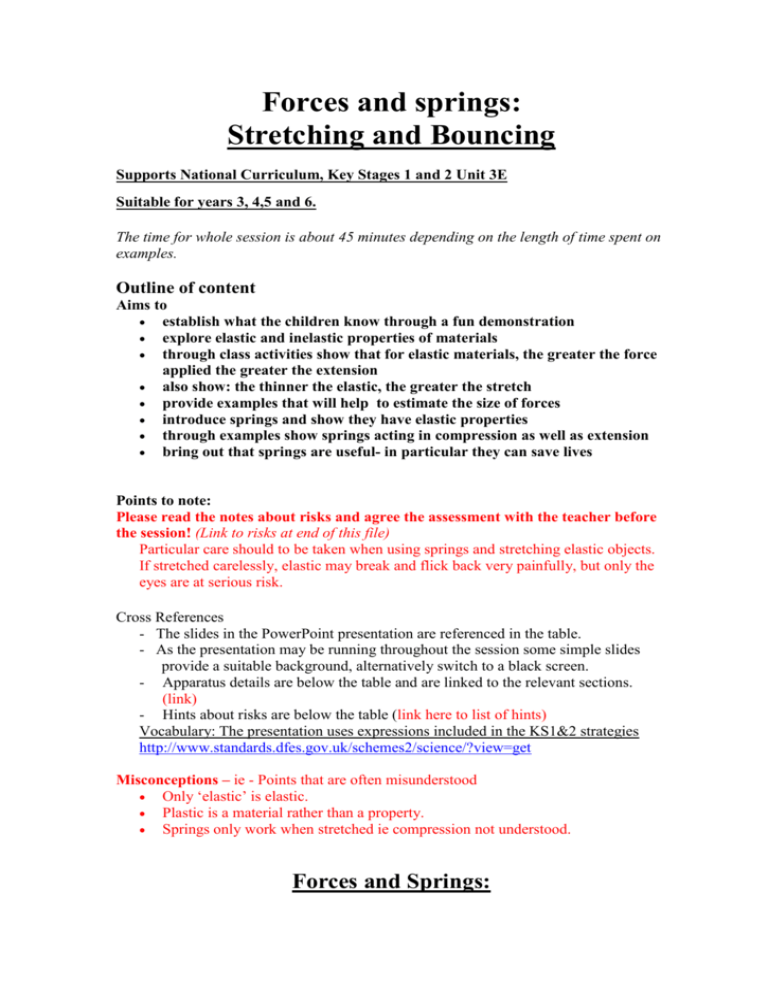
Forces and springs: Stretching and Bouncing Supports National Curriculum, Key Stages 1 and 2 Unit 3E Suitable for years 3, 4,5 and 6. The time for whole session is about 45 minutes depending on the length of time spent on examples. Outline of content Aims to establish what the children know through a fun demonstration explore elastic and inelastic properties of materials through class activities show that for elastic materials, the greater the force applied the greater the extension also show: the thinner the elastic, the greater the stretch provide examples that will help to estimate the size of forces introduce springs and show they have elastic properties through examples show springs acting in compression as well as extension bring out that springs are useful- in particular they can save lives Points to note: Please read the notes about risks and agree the assessment with the teacher before the session! (Link to risks at end of this file) Particular care should to be taken when using springs and stretching elastic objects. If stretched carelessly, elastic may break and flick back very painfully, but only the eyes are at serious risk. Cross References - The slides in the PowerPoint presentation are referenced in the table. - As the presentation may be running throughout the session some simple slides provide a suitable background, alternatively switch to a black screen. - Apparatus details are below the table and are linked to the relevant sections. (link) - Hints about risks are below the table (link here to list of hints) Vocabulary: The presentation uses expressions included in the KS1&2 strategies http://www.standards.dfes.gov.uk/schemes2/science/?view=get Misconceptions – ie - Points that are often misunderstood Only ‘elastic’ is elastic. Plastic is a material rather than a property. Springs only work when stretched ie compression not understood. Forces and Springs: Stretching and Bouncing 1. Activities Discussion Aims/facts Show them the PEANUTS label on the snake tin. Explain that you have had a problem with the lid and not been able to open it for a while. Explain that one problem with peanuts is that they get worms in them. Then open the tin, pointing it slightly forwards so that the snake or worm springs forwards. (see apparatus list) Ask the children what has caused the worm to spring out. They will quickly explain that there is a spring inside. Continue the discussion to find out what they know. Show slide 2 which is animated. Repeating the demonstration often helps. Include the words pushes and pulls in the discussion. Discuss the changes in length of the fashion string which stays stretched and the elastic which springs back when released. (See safety notes.) Explain that they show plastic and elastic behaviour. Show the animated slides 3 and 4 to help the discussion. The elastic stretches to many times its original length. All the children can feel that the force on the elastic is increasing as the length increases. Emphasise that the children must carefully pass the elastic back the way it came. Discuss the fact that the elastic shrinks back to its original length. Establish what the children know about springs. 2. Hand 2 lengths of ‘fashion string’ to each class group and ask each group to pull one of the strings and then compare it with the unstretched one. Then hand out a similar length of fishing pole elastic and ask them to gently stretch this. (see apparatus list) 3. Slide 5 Show a long length of fishing pole elastic and pass the loop at one end to the nearest child. Keep hold of the loop at the other end. Explain that they will have to be very sensible and not let go of the elastic. Also, they must not pull very hard. Then ask the child with the elastic to pass the end to the next child whilst you keep hold of the elastic. This should be repeated so the elastic is threaded round the class. Throughout the game, keep hold of your loop and before the tension becomes large stop the game by releasing the tension slowly. (see apparatus list) Plastic and elastic materials introduced. The greater the force the greater the extension. 4. 5. 6. 7. 8. 9. (see safety notes) Show the class some ‘stretchimals’ or similar elastic toys. Slide 6, 7 Hand two stretchimals with different shapes to each group. Ask them to stretch them by slowly increasing the force applied. Slide 8 (see apparatus list) (see safety notes) Explain that it is very useful to be able to estimate the size of a force. Slide 10 gives some useful values that they can remember. Slide 11 Ask the groups try to apply the same pull to the two differently shaped stretchimals. Show slide 12 and ask if the blue lizard will be longer or shorter than the red frog when the 10 newton force pulls on it. Slide 13, 14 Take the opportunity to re-cap. Then use slide 14 to reinforce the ideas. Slide 15 – Springs Explain that springs have elastic properties. Ask a volunteer to grip one end of a ‘slinky’ spring firmly and not to let go until you say. Holding the other end of the slinky, walk back across the front of the class so that the ‘slinky’ stretches. (see apparatus list) Ask volunteers to stand in a line and hold 4 or 5 similar springs. Hang objects of different weights on the springs. Compare the amount the springs are stretched. (see apparatus list) 10. Show a toy that has a spring in it Discuss what they find out. Take the opportunity to discuss their understanding of a force. Slide 9 Reinforce: the greater the force the greater the extension. This could be extended if newtonmeters are available to check estimates. Point out that the ‘greater the force, the greater the increase in length’ applies for all the shapes. But the thinner the toy the longer the extension for a particular size of force. Developing estimating skills Different thicknesses require different forces to stretch them by the same amount. Revision Springs change length when a force is applied and return to their original length when the force is removed. Larger forces cause larger changes than small forces. Shaking the end of the end of the spring so that a transverse wave is seen helps to get across a message that ‘springs can make things happen’. Use this as an opportunity to estimate the force on each spring, e.g. an apple will exert a force of about 1 newton etc. (This is an example of a Springs have elastic properties. The larger the force on the spring the larger the extension. Springs can make such as the woodpecker that pecks as it slides down the rod. Show the animated slide 16 (see apparatus list) 11. Ask for examples of where springs are used. Demonstrate examples of uses of springs in toys, wind-up toys, sports equipment e.g. a tennis racquet etc and other items that you have brought. (see apparatus list) (see safety notes) 12. Point out that some springs are springy when they are squashed rather than stretched. ( We say they are ‘compressed’.) Show examples of objects that use springs using slides 17 and 18 and hand round some examples for groups to inspect. (see safety notes) Ask what happens to the shape of a cushion or mattress as they sit on a chair or get into bed. 13. Ask if they have been on a bouncy castle and what would happen if it was too hard or too soft. 14. Show slide 19 15. Medical application: stents Explain that springs save lives. Show slide 20 Explain that stents are tiny springs made of very special metal that remembers its shape. When a stent is squashed it later springs back to its original shape. 16. Slide 21( animated so the steps can be shown individually) Explain that a special tube, called a catheter, is threaded all the way spring making a to-andfro movement possible. It is called an ‘oscillation’.) Use the discussion to point out that there are numerous examples and many are hidden. things happen. Discuss examples. Ask why the bed shown in the cartoon (in slide 18) must be very hard. They soon notice that the mattress is absolutely flat so the weight of the character is not enough to squash the springs. Some springs are compressed when forces are applied. Unlike elastic which only works in extension. Discuss examples of springy surfaces that are firm such as the surface of a play area. Discuss the examples. Explain that some people may have a blockage which prevents the blood flowing round the heart. A stent can be inserted which keeps the artery open so the blood can flow. Discuss the problems. That the metal must not corrode, that the spring must be very, very small. During discussion emphasise that this is now a very common procedure that makes Some springs are more firm than others. Springs are useful Springs save lives Physics (science) saves lives. through the arteries in the body from the leg to the heart. The catheter can be seen throughout this process by special scans that have been developed using physics. When the catheter reaches the correct position, a tiny balloon pushes on the stent so it opens the artery. The stent then stays in place as the catheter and balloon are withdrawn. helps to reduce the likelihood of heart attacks. Make the point that many of the techniques now used by the medical profession have been developed using physics. Slide 22 Safety Notes Springs and elastic are unlikely to injure skin seriously: the odd nip can be regarded as a learning experience. However, they may permanently damage eyes. Eye protection should be worn whenever there is a chance that an elastic cord or a spring may flick into the eye. When demonstrating using the long length of fishing pole elastic, ensure that the tension does not become large. If there is any misbehaviour avoid the exercise or stop it immediately. Ensure that the tension is released gently. Apparatus 1. Introduction Jack-in-a-box type toy. E.g. a tin stating it contains peanuts but which has a springy ‘worm’ in it. Available from on-line novelty suppliers or novelty shops. 2. Elastic and inelastic properties A pack of ‘fashion string’ as available from toy shops. (PVC ‘string’ used to make plaited bracelets etc) Fishing pole elastic. Available from anglers’ suppliers. Lengths of ~10 metres are sold for about £2. ( Buy 2 lengths and save one for use in activity 3.) Cut the fashion string into lengths of about 30 cm so there are sufficient pieces for 2 pieces for each group. Cut sufficient 30 cm lengths of fishing pole elastic so that there is one piece for each group of 4 children. 3. A long length of fishing pole elastic. Tie a loop at each end to serve as good handles to hold the elastic firmly. 4. Packs of stretchimals or similar latex toys available from on-line novelty suppliers or novelty shops. Enough for two individual items of different shape for each group of children. 8. Slinky spring - available from school science labs or from on-line novelty suppliers or novelty shops 9. * 10, 11. 6 springs which stretch several centimetres when subjected to a 1 newton load. (Any such available springs could be utilised. Alternatively, springs might be borrowed from school science labs.) Objects of various weights that can be suspended on the springs e.g. a lime, a lemon, an orange and a grapefruit. These are familiar objects and their size is closely linked with load on the springs. Before the visit make string loops or other simple arrangements so that objects can be suspended from the springs. If fruit is used, before the session, tie tapes round the fruit so that it can be suspended from the springs. Examples of familiar items with springs in them. For example: toys including wind-up toys, sports equipment such as tennis racquets, etc Note: Examples of toys which have springs in them change rapidly. Look for examples that are fun and novel!





